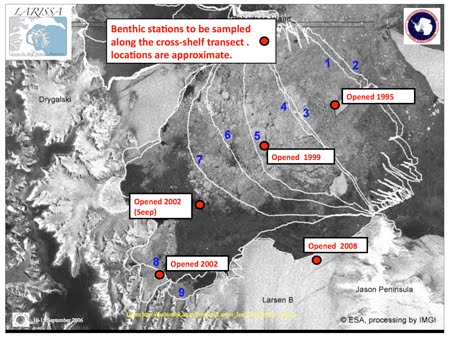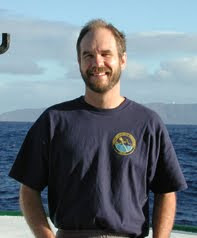
Satellite image showing heavy sea-ice cover throughout our desired study area in the Larsen B vicinity (dashed circle). Flat whit areas are sea ice and ice shelves; ruffled areas throwing shadow are clouds. In most years, the circled area is clear of sea ice by the end of January. The heavy sea conditions this year illustrate the high interannual variability in weather conditions in the Antarctic – even though climate warming continues at a very fast rate in this region, during some years, sea ice may still persist throughout the summer due to stochastic weather processes.
Before leaving Lockyer Station, we had a bit of a scare, and a reminder that the Antarctic is still a remote and potentially dangerous environment. Two of our party, a geologist and writer for National Geographic, were flown by helicopter to a site on the Antarctic Peninsula 25 miles away to collect glacial erratics (rocks dropped by glaciers far from their site of origin). As they were working, the weather began to close in so they helicopter flew out the pick them up and return them to the ship. During the return flight (only about 15 minutes), the weather closed in even further, and whiteout conditions forced the helicopter, with three aboard, to land on a beach on James Ross Island only 6 miles from the ship. A snow storm ensued for the next three days, grounding the scientist, writer and helicopter pilot in two small tents for three days. The helicopters always travel with emergency rations for 6 days, sleeping bag s and tents, so the stranded party was is in no immediate danger. However, it was sobering to realize that while they were only 6 miles from us, there was nothing we or anyone else on earth could do for them until the snow storm abated. After 3 days, we finally had a patch of blue sky in which to recover our now smelly shore party. They had spent their time digging a latrine, building snow walls to protect the tents from the 30 inches of snow fall, and reading and dozing in their sleeping bags. The National Geographic writer now has quite a story to tell about forced camping in the Antarctic wilderness, an experience somewhat reminiscent of the stranding of Shackleton’s shore party on Elephant Island, 180 miles north of here.

The snow storm that stranded three of our expedition members on James Ross Island for three days.
Following recovery of our wayward three, the NB Palmer crashed northward through very thick sea ice, making only 2-4 knots for 26 hours. As we entered the Antarctic Sound, the strait between the Weddell and Scotia Seas at the north end of the Antarctic Peninsula, the sea ice thinned and we were able to make much better time. By evening of the 13th we were in position for an ROV dive on a recently discovered submerged volcano in the Antarctic Sound, to search for hydrothermal vents to provide study organisms for David Honig and Mike McCormick. The ROV dive found no vents, but did reveal dense communities of sponges, crinoids (see lilies), brittle stars and other suspension feeders characteristic of the Antarctic seafloor. It is thought that such communities can thrive in the Antarctic only because large crushing predators, such as king crabs and bottom feeding sharks, are excluded by the very cold Antarctic waters (below 0 centigrade). Such communities of exposed suspension feeders occurred worldwide in the ancient ocean, but apparently were eliminated with the evolution of large crabs and bottom-feeding sharks. The lack of these large, skeleton-crushing (or duraphagous) predators in the Antarctic has allowed the radiation of a diverse assemblage of suspension feeders unique to Antarctic waters. As climate change brings warmer waters to the Antarctic, skeleton-crushing predators, especially king crabs, threaten to invade shallow waters around the Antarctic Peninsula, potentially leading to the extinction of many unique Antarctic species. During the dive we also observed giant “barrel” sea anemones that apparently roll along the seafloor without a permanent attachment. This may be an adaptation to utilize habitats newly exposed by the bulldozing of the seafloor by grounding icebergs, a major source of disturbance for seafloor habitats at depths less than 300 m in Antarctica.

The NB Palmer breaking its way though multi-year sea ice south of the Antarctic Sound.

A dense assemblage of suspension feeding sea lilies (crinoids, plumose yellow animals), brittle stars, sponges (white blobs and shapes), and octocorals (pink trees) on the seafloor at 500 m depths on the submerged volcano in the Antarctic Sound. This is classic, high-biomass, exposed Antarctic benthic assemblage is likely to be very susceptible to predation from invading king crabs.

Barrell anemone approximately 30 cm (12 inches) long rolling along the seafloor on the Antarctic Sound submerged volcano.





No comments:
Post a Comment